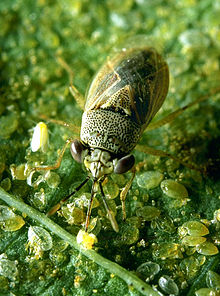Geocoris
| Geocoris | |
|---|---|

| |
| Geocoris punctipes | |
| Scientific classification | |
| Kingdom: | |
| Phylum: | |
| Class: | |
| Order: | |
| Suborder: | |
| Family: | |
| Subfamily: | |
| Genus: | Geocoris Fallén, 1814
|
Geocoris is a genus of insects in the family Geocoridae (although in the past the geocorids were subsumed as a subfamily under the family "Lygaeidae"). Commonly known as big-eyed bugs, the species in Geocoris are beneficial predators, but are often confused with the true chinch bug, which is a pest.[1][2]
Big-eyed bugs are true bugs in the order Hemiptera. The two most common species are Geocoris pallens and Geocoris punctipes. Both are predators and occur in many habitats, including fields, gardens, and turf grass. Big-eyed bugs are considered an important predator in many agricultural systems and feed on mites, insect eggs, and small insects such as pink bollworm, cabbage loopers and whiteflies. Adult big-eyed bugs are small (about 3 mm) black, gray, or tan with proportionately large eyes. Eggs are deposited singly or in clusters on leaves near potential prey. They develop with incomplete metamorphosis (there is no pupa) and take approximately 30 days to develop from egg to adult depending on temperature. Both nymphs and adults are predatory, but can survive on nectar and honeydew when prey are scarce. Big-eyed bugs, like other true bugs, have piercing-sucking mouthparts and feed by stabbing their prey and sucking or lapping the juices. Although their effectiveness as predators is not well understood, studies have shown that nymphs can eat as many as 1600 spider mites before reaching adulthood, while adults have been reported consuming as many as 80 mites per day.[3][4]
Species
- Geocoris acuticeps Signoret, 1881
- Geocoris arenarius (Jakovlev, 1867)
- Geocoris ater (Fabricius, 1787)
- Geocoris chloroticus Puton, 1888
- Geocoris collaris Puton, 1878
- Geocoris confalonierii (de Bergevin, 1932)
- Geocoris desertorum (Jakovlev, 1871)
- Geocoris dispar (Waga, 1839)
- Geocoris erythrocephalus (Lepeletier & Serville, 1825)
- Geocoris erytrops (Dufour, 1857)
- Geocoris grylloides (Linnaeus, 1761)
- Geocoris lapponicus Zetterstedt, 1838
- Geocoris lineola (Rambur, 1839)
- Geocoris megacephalus (Rossi, 1790)
- Geocoris oschanini (Jakovlev, 1871)
- Geocoris pallidipennis (A. Costa, 1843)
- Geocoris phaeopterus (Germar, 1838)
- Geocoris pubescens (Jakovlev, 1871)
- Geocoris punctipes (Say, 1832)
- Geocoris uliginosus (Say)
References
- ^ "Managing lawn and turf insects: blade-sucking: Predator: Big-eyed bug (Geocoris, Family Gelastocoridae, Order Hemiptera)". Extension Service, University of Minnesota. Archived from the original on 30 September 2013.
{{cite web}}: Unknown parameter|deadurl=ignored (|url-status=suggested) (help) - ^ Kastl, Herbert J. (1964). "Control of the Hairy Cinch Bug in Turf". Bulletin of the New York State Turfgrass Association. 73: 302.
- ^ Schuh, Randall T. and Slater, James Alexander (1995). True Bugs of the World (Hemiptera: Heteroptera). Ithaca, New York: Cornell University Press. ISBN 978-0-8014-2066-5.
{{cite book}}: CS1 maint: multiple names: authors list (link) - ^ Ashlock, P. D., and Slater, A. (1988). "Family Lygaeidae". In Henry, Thomas J. and Froeschner, Richard C. (ed.). Catalog of the Heteroptera, or True Bugs, of Canada and the Continental United States. Leiden, Netherlands: E. J. Brill. pp. 167–245. ISBN 978-0-916846-44-2.
{{cite book}}: CS1 maint: multiple names: authors list (link)
External links
- Geocoris spp. on the UF / IFAS Featured Creatures Web site
